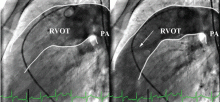When ‘blue babies’ grow up: What you need to know about tetralogy of Fallot
ABSTRACTMost babies born with tetralogy of Fallot undergo corrective surgery and survive to adulthood. However, as they get older they are prone to a number of long-term problems, and they often do not receive expert-level follow-up care. This review of the adult complications of tetralogy of Fallot should help primary care practitioners identify these patients, make appropriate and timely referrals, and educate patients and their families.
KEY POINTS
- The major long-term complication of tetralogy of Fallot repair is pulmonary valve insufficiency, which leads to right heart failure. Other problems include atrial and ventricular arrhythmias and sudden cardiac death.
- Surgical pulmonary valve replacement is the standard of care, but the optimal time to do this is unclear.
- Novel and experimental therapies include percutaneous pulmonary valve replacement and medical therapy with pulmonary arterial vasodilators.
WHAT HAPPENS YEARS AFTER SURGICAL REPAIR?
Surgery used to be considered the definitive cure for tetralogy of Fallot. However, problems that arise years later include chronic pulmonary valve insufficiency, obstruction of the right ventricular outflow tract, depressed right ventricular function, residual ventricular septal defect leaks, and arrhythmias.17,21,22 For these reasons, many experts have abandoned the notion that surgical repair is definitive. 23,24
Pulmonary valve insufficiency leads to right ventricular systolic dysfunction
In the past, pulmonary insufficiency was considered relatively benign because most patients tolerate it well for a long time. As these patients age, however, it becomes the core of their problems.1 If severe, it may result in right ventricular volume overload and dilatation, fibrosis, arrhythmia, and myocardial damage, all of which are cumulatively detrimental.25 Right ventricular function and exercise capacity deteriorate, and the tendency toward ventricular arrhythmias develops.26
If the problem is chronic, right ventricular systolic function may remain normal for years, during which most patients remain relatively free of symptoms. In time, however, the compensatory mechanisms of the right ventricular myocardium fail, the right ventricular wall stress (afterload) increases, while the right ventricular ejection fraction decreases. Patients begin to experience symptoms, and if the volume load is not reduced, the dysfunction may become irreversible.27
PULMONARY INSUFFICIENCY PREDISPOSES TO ARRHYTHMIAS, SUDDEN CARDIAC DEATH
Pulmonary insufficiency predisposes to atrial and ventricular arrhythmias, presumably due to progressive enlargement and stretching of the right atrium and ventricle.
Clinically significant atrial arrhythmias, predominantly intra-atrial reentrant tachycardia but also atrial tachycardia and atrial fibrillation, occur in 12% to 35% of patients with repaired tetralogy of Fallot.11,28–31
Ventricular arrhythmias and sudden cardiac death also occur. In one study,1 100% of patients who died suddenly had moderate or severe pulmonary insufficiency, and 94% with ventricular tachycardia had significant pulmonary insufficiency. In contrast, only 49% of patients who were arrhythmia-free had significant pulmonary insufficiency. None of the patients with late sudden death or ventricular tachycardia had undergone late pulmonary valve replacement. This is further supported by a multicenter analysis of patients with repaired tetralogy, which demonstrated that moderate or severe pulmonary insufficiency was the main hemodynamic abnormality in patients with ventricular tachycardia and sudden death.11
In general, the risk of late sudden death is 25 to 100 times higher in patients who survive surgery for congenital heart disease than in age-matched controls, and the risk is even higher for those with cyanotic conditions such as tetralogy of Fallot. In fact, one-third to one-half of deaths in adults with tetralogy of Fallot are sudden.25,32
FINDINGS ON ASSESSMENT
Most patients with tetralogy of Fallot remain free of symptoms for many years. While individual responses to pulmonary insufficiency vary, symptoms generally get worse as the pulmonary insufficiency gets worse. Patients present with a spectrum of complaints, from palpitations to a general decline in function. Late symptoms include exertional dyspnea, palpitations, right heart failure, and syncope.17
Signs of right ventricular failure can include elevated jugular venous pressure, peripheral edema, hepatomegaly, ascites,33 and jugular venous distention with a large a wave.
Heart murmurs
Pulmonary insufficiency causes a low-pitched, brief diastolic murmur. Although often present, it may be short or difficult to hear, even if the regurgitation is severe, because this is “low-pressure” pulmonary insufficiency as opposed to the regurgitation that can occur in patients with pulmonary hypertension. Therefore, this murmur is often missed on physical examination.
There may be an ejection click due to a dilated aorta. An aortic insufficiency murmur may also be present.
A right ventricular outflow murmur is generally audible, along with a pansystolic murmur if a residual ventricular septal defect is also present.
A right-sided aortic arch, present in about 25% of patients with tetralogy of Fallot, may cause a lift below the right sternoclavicular junction.17
Electrocardiographic findings
Electrocardiography commonly shows right ventricular hypertrophy with a right bundle branch block. The longer the QRS duration, the greater the right ventricular volume and mass. Furthermore, a QRS duration greater than 180 ms is a significant marker of risk of ventricular arrhythmias and sudden death.22,34–37
Another feature strongly associated with ventricular arrhythmias and sudden death is the rate of change in the QRS duration. A relatively rapid increase (> 3.5 ms/year) is associated with a significantly higher risk.1 A rapid rate of change may be meaningful even if the QRS duration is not markedly prolonged.11
Reduced heart rate variability also appears to be a marker of risk of sudden cardiac death in these patients.38,39







